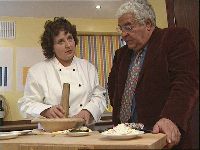
When the Romans arrived in ancient Britain they brought with them a new way of life – new customs, new religions, new foods and new ways of cooking. Food historian Sally Grainger and top gourmet cook Antonio Carluccio visit the Open Minds kitchen to tempt us with some tasty Roman treats.
Whilst cooking Libum and Stuffed Kidneys, Sally demonstrates two Roman cooking tools. The Mortaria is much like a shallower version of a modern mortar, baked with grit in the base to make it very efficient for creating pastes. The Testun is a Roman oven, much like an upturned casserole dish with a hole in the top. There is also a surrounding ledge on which coals were burned making it a very efficient cooking device.

Much of what we know of Roman cooking comes from a cookery book written by Apicius in around 450AD. It contains many exotic dishes and was clearly written for a wealthy family. Apicius, however, gave only hints as to the amounts of each ingredient so Sally has developed her recipes through experimentation with the ingredients listed.
The Romans took influences from all over the world, and their cooking was no different. Many of their recipes come from the Greeks – Libum for example. This would have been used by the Romans in sacrificial offerings and then eaten by the slaves working in the temples. There is even a story of a slave boy who ran away as he couldn’t face any more of the sweet dish.
Roman cooking was traditionally highly flavoured and they used many spices we would consider strange today. Sally also brings along a garlic cheese spread – a very strong paste made with 50 cloves of garlic to every pound of cheese.
Food was very important to the Romans, as it is to many modern day Italians! They held many orgies, of which food was a principal element, and ate their food with their fingers. However, the Roman influence on modern Italian cooking is only slight, although Antonio did spot a couple of similarities – the stuffed kidneys recipe is similar to a modern Italian dish from the Neopolitan area which uses liver as the main ingredient instead of kidneys and the pine kernel sauce also reminds him of a modern day sauce originating in Piedmont.
Recipes
Libum (Cheesecake)
4oz (1 cup/120g) plain flour
8oz (225g) ricotta cheese
1 egg, beaten
bay leaves
4oz (½ cup/120g) clear honey
- Sift the flour into a bowl.
- Beat the cheese until it is soft and stir it into the flour along with the egg.
- Form a soft dough and divide into four. Mould each one into a bun and place them on a greased baking tray with a fresh bay leaf underneath.
- Heat the oven to 425°F (200°C/gas mark 7). Bake for 35 to 40 minutes until golden brown.
- Warm the honey and place the warm cakes in it so that they absorb it. Allow to stand for 30 minutes before serving.
© the British Museum, British Museum Press
Stuffed Kidneys
8 lamb’s kidneys
10 fennel seeds, roasted for 5 mins in a moderate oven
4oz (1 cup/120g) pine kernels, soaked overnight in white wine
1 generous handful of fresh coriander
1 level teaspoon ground black pepper
2 tablespoons (30ml) olive oil
2 tablespoons (30ml) fish sauce
1 pig’s caul (optional)
- Skin the kidneys, split in half and remove any fibres.
- In a mortar, pound the fennel seeds to a coarse powder.
- Strain the pine kernels and add them to the mortar with the coriander. Continue to pound the mixture until it is of a uniform texture. Add the pepper.
- Place a spoonful of the mixture in the centre of each kidney and close them up. If you can obtain pig’s caul from a butcher, use it to wrap each kidney to prevent the stuffing from coming out, otherwise sew up with a little cotton thread or secure with a cocktail stick.
- Combine the oil and fish sauce in a frying pan and heat. Seal the kidneys for two minutes on each side, then transfer them and the sauce to a small baking dish and finish in a pre-heated oven at 350°F (180°C/gas mark 4) for a further ten minutes.
- Serve as a first course or as a light snack.
© the British Museum, British Museum Press
Pine Kernel Sauce
1 teaspoon celery seed
1 teaspoon cumin
8 peppercorns
1 teaspoon dried mint
1 teaspoon dried thyme
1 teaspoon dried savory
2oz pine kernals
1 tablespoons white wine
1 tablespoon clear honey
1 tablespoon white wine vinegar
1 tablespoon fish sauce
1 teaspoon olive oil
- Dry roast the celery and cumin in a frying pan. Pound with the peppercorns to a fine powder and add the mint, thyme and savory.
- Dry roast the pine kernels until golden brown then place in a blender with the spice mixture and grind until it makes a smooth paste.
- Add the liquids, one at a time, blending well between each addition.
- Place the finished sauce into a sauce pan and heat until it simmers. Serve with a slice of pork, or wild boar if possible.
Courtesy of Sally Grainger
Further reading
The Classical Cookbook
Andrew Dalby and Sally Grainger, British Museum Press
The Roman EmpireC Wells, Fontana History of the Ancient World
The Roman World 44BC-AD180M Goodman, Routledge History of the Ancient World
Roman Civilization: Selected Readings Volume II The Empire
N Lewis, M Reinhold, Columbia University Press
Find out more about studying history with the Open University.
Rate and Review
Rate this activity
Review this activity
Log into OpenLearn to leave reviews and join in the conversation.
Activity reviews